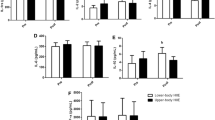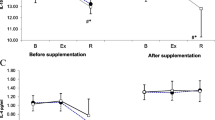Abstract
This study was aimed to evaluate the possible changes caused by a single bout of moderate-intensity exercise in a hot environmental temperature on the immune function and on inflammatory markers. A total of 22 young male adults (VO2max, 55.4±3.6 ml·kg−1·min−1) volunteered to participate in an exercise session of 60 minutes on a treadmill ergometer at moderate speed (60% of the maximum aerobic speed) in hot environmental conditions (35°C and humidity 60%). Total leukocyte numbers, lymphocyte subsets (CD8+, CD4+, CD3+, NK and CD19+), cytokine production capacity by peripheral blood mononuclear cells (PBMCs) (IL-2, IL-4, IL-5, IL-10, IFN-γ and TNF-α) as well as the concentration of several inflammation related proteins (ceruloplasmin, C-reactive protein (CRP), complement factors C3 and C4) were evaluated before and after exercise. The results show that leukocyte and neutrophil absolute values increased (P<0.001) after the exercise period. In contrast, eosinophil values decreased (P<0.05) after the exercise. In addition, ceruloplasmin, C3 and C4 values (P<0.05) increased after exercise. No changes in T lymphocyte subsets, cytokine production, or CRP were observed. These data confirm previous studies suggesting that a 60 min exercise in a hot environment is enough to cause a physiologic adaptation to these special conditions leading to an increase of non-specific immune cells and promoting inflammatory processes. On the other hand, PCR values, lymphocyte subsets and the capacity of cytokine production by PBMC were not changed in a relatively short bout of exercise under these conditions in contrast with previous studies.
Resumen
El objetivo fue evaluar los posibles cambios producidos en marcadores inmunológicos y de inflamación, tras una prueba de ejercicio físico a una intensidad moderada y bajo un entorno de alta temperatura. Para ello, participaron voluntariamente un total de 22 varones jóvenes (VO2max, 55.4±3.6 ml·kg−1·min−1) en un protocolo de carrera en tapiz rodante durante 60 minutos a una velocidad moderada (al 60% de su velocidad aeróbica máxima), y bajo una entorno controlado de alta temperatura (35°C y 60% de humedad relativa). Se determinaron los parámetros correspondientes a la serie blanca (leucocitos totales y sus diferenciales), subpoblaciones de linfocitos CD8+, CD4+, CD3+, NK y CD19+, capacidad de producción de citoquinas IL-2, IL-4, IL-5, IL-10, IFN-γ y TNF-α, así como concentración de proteínas relacionadas con la inflamación (ceruloplasmina, proteína C reactiva y factores del complemento C3 y C4), antes y después de realizar la prueba de ejercicio físico. Los resultados mostraron un aumento significativo (P<0.001) en los valores absolutos de leucocitos y neutrófilos tras el ejercicio. Por otro lado, los valores de eosinófilos (P<0.05) disminuyeron después de la prueba. Los valores correspondientes a ceruloplasmina, C3 y C4 aumentaron (P<0.05) tras el ejercicio. Los resultados del presente estudio confirman estudios previos, y sugieren que 60 minutos de ejercicio en altas temperaturas es suficiente para producir una adaptación fisiológica a esas condiciones (aumento de las células responsables de la respuesta inmune inespecífica y de procesos inflamatorios). Sin embargo, no se observaron cambios en la proteína C reactiva, subpoblaciones de linfocitos, ni en la capacidad de producción de las citoquinas tras el ejercicio.
Similar content being viewed by others

References
Brines R., Hoffman-Goetz, L. and Pedersen, B.K. Can you exercise to make your immune system fitter? (1996): Immunol Today, 17, 252–254.
Brolinson, P.G, Elliott, D. Exercise and the immune system. (2007): Clin Sports Med, 26, 311–319.
Dill, D.B. and Costill, D.L. Calculation of percentage changes in volumes of blood, plasma, and red cells in dehydration. (1974): J Appl Physiol, 37, 247–248.
Gleeson, M. Immune function in sport and exercise. (2007): J Appl Physiol, 103, 693–639.
Kasapis, C. and Thompson, P.D. The effect of physical activity on serum C-reactive protein and inflammatory markers: a systematic review. (2005): J Am Coll Cardiol, 45: 1563–1569.
Klentrou, P., Cieslak, T., McNeil, M., Vintinner, A. and Plyley, M. Effect of moderate exercise on salivary IgA and infection risk in humans. (2002): Eur J Appl Physiol, 87, 153–158.
Leger, L. and Boucher, R. An indirect continuous running multistage field test: the Universite de Montreal track test. (1980): Can J Appl Sport Sci, 5, 77–84.
Lim, C.L., Byrne, C., Chew, S.A. and Mackinnon, L.T. Leukocyte subset response during exercise under heat stress with carbohydrate or water intake (2005): Aviat Space Environ Med, 76, 726–732.
MacKinnon, L.T. Current challenges and future expectations in exercise immunology: back to the future. (1994): Med Sci Sports Exercise, 26, 191–194.
Matthews, C.E., Ockene, I.S., Freedson, P.S., Rosal, M.C., Merriam, P.A. and Hebert, J.R. Moderate to vigorous physical activity and risk of upper-respiratory tract infection. (2002): Med Sci Sports Exerc, 34: 1242–1248.
Maughan, R.J., Shirreffs, S.M. and Watson, P. Exercise, heat, hydration and the brain. (2007): J Am Coll Nutr, 26, 604–612.
McFarlin, B.K. and Mitchell, J.B. Exercise in hot and cold environments: differential effects on leukocyte number and NK cell activity. (2003): Aviat Space Environ Med, 74, 1231–1236.
Mitchell, J.B., Dugas, J.P., McFarlin, B.K. and Nelson, M.J. Effect of exercise, heat stress, and hydration on immune cell number and function. (2002): Med Sci Sports Exerc, 34, 1941–1950.
Montain, S.J., Latzka, W.A. and Sawka, M.N. Impact of muscle injury and accompanying inflammatory response on thermoregulation during exercise in the heat. (2000): Appl Physiol, 89, 1123–1130.
Moshage, H.J., Roelofs, H.M., van Pelt, J.F., Hazenberg, B.P., van Leeuwen, M.A., Limburg, P.C., Aarden, L.A. and Yap, S.H. The effect of interleukin-1, interleukin-6 and its interrelationship on the synthesis of serum amyloid A and C-reactive protein in primary cultures of adult human hepatocytes. (1998): Biochem Biophys Res Commun, 155, 112–117.
Nieman, D.C. and Pedersen, B.K. Exercise and immune function. Recent developments. (1999): Review Sports Med, 27, 73–80.
Nieman, D.C. Current perspective on exercise immunology. (2003): Curr Sports Med Rep, 22, 239–242.
Pedersen, B.K. and Nieman, D.C. Exercise and immunology: integration and regulation. (1998): Immunol Today, 19, 204–206.
Pedersen, B.K. and Hoffman-Goetz, L. Exercise and the immune system: regulation, integration, and adaptation. (2000): Physiol Rev, 80, 1055–1081.
Pedersen, B.K. and Hoffman-Goetz, L. Exercise as a stress model and the interplay between the hypothalamus-pituitary-adrenal and the hypothalamus-pituitary-thyroid axes. (2005): Horm Metab Res, 37, 577–584.
Rhind, S.G., Gannon, G.A., Shephard, R.J., Buguet, A., Shek, P.N. and Radomski, M.W. Cytokine induction during exertional hyperthermia is abolished by core temperature clamping: neuroendocrine regulatory mechanisms. (2004): Int J Hyperthermia, 20, 503–516.
Romeo, J., Wärnberg, J., Nova, E., Díaz, L.E., González-Gross, M. and Marcos, A. Changes in the immune system after moderate beer consumption (2007): Ann Nutr Metab, 51, 359–366.
Severs, Y., Brenner, I., Shek, P.N. and Shephard, R.J. Effects of heat and intermittent exercise on leukocyte and sub-population cell counts. (1996): Eur. J Appl Physiol Occup Physiol, 74, 234–245.
Shephard, R.J. Exercise under hot conditions: a major threat to the immune response? (2002): J Sports Med Phys Fitness, 42, 368–378.
Starkie, R.L., Hargreaves, M., Rolland, J. and Febbraio, M.A. Heat stress, cytokines, and the immune response to exercise. (2005): Brain Behav Immun, 19, 404–412.
Walsh, N.P. and Whitham, M. Exercising in Environmental Extremes A Greater Threat to Immune Function? (2006): Sports Med, 36, 941–976.
Author information
Authors and Affiliations
Corresponding author
Rights and permissions
About this article
Cite this article
Romeo, J., Jiménez-Pavón, D., Cervantes-Borunda, M. et al. Immunological changes after a single bout of moderate-intensity exercise in a hot environment. J. Physiol. Biochem. 64, 197–204 (2008). https://doi.org/10.1007/BF03178842
Received:
Issue Date:
DOI: https://doi.org/10.1007/BF03178842



